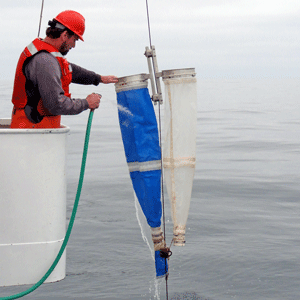 A Pairovet vertical plankton tow is performed at all stations inshore of, and including station 70. The Pairovet net fishes from 70 meters to the surface (depth permitting) using paired 25 cm diameter 150 um mesh nets. The technical requirements for Pairovet tows are: Descent rate of 70 meters per minute, ascent rate of 70 meters per minute. All tows with wire angles exceeding 15 degrees during the ascent will be repeated.
A Pairovet vertical plankton tow is performed at all stations inshore of, and including station 70. The Pairovet net fishes from 70 meters to the surface (depth permitting) using paired 25 cm diameter 150 um mesh nets. The technical requirements for Pairovet tows are: Descent rate of 70 meters per minute, ascent rate of 70 meters per minute. All tows with wire angles exceeding 15 degrees during the ascent will be repeated.
 The paired tows of vertical egg nets, referred to as PV in the CalCOFI database, was the replacement for the CALVET in 1982. The PAIROVET is a bongo-type version of the CALVET consisting of two nets instead of one. The frame was designed to facilitate comparison of nets constructed of various materials and to provide replicate observations when using similar nets. The frame is constructed of 6061-T6 aluminum with stainless steel fittings. The nets are nylon mesh attached to the frame with adjustable stainless steel strapping.
The paired tows of vertical egg nets, referred to as PV in the CalCOFI database, was the replacement for the CALVET in 1982. The PAIROVET is a bongo-type version of the CALVET consisting of two nets instead of one. The frame was designed to facilitate comparison of nets constructed of various materials and to provide replicate observations when using similar nets. The frame is constructed of 6061-T6 aluminum with stainless steel fittings. The nets are nylon mesh attached to the frame with adjustable stainless steel strapping.
CV...CALVET Net
The vertical egg tow, referred to as CV in the CalCOFI database, was used to sample anchovy eggs from 1980 through 1985. The net frame consisted of either a single or pair of anodized aluminum circles, 0.25 m in diameter, connected directly to the towing cable, to which elongate cylindrical-conical shaped nets were attached. The nets were 1.5 m in length, a 0.8 m cylindrical portion joined to 0.6 m conical portion tapering to a 0.1 m cod end. From 1980 through 1982 the net was made of 0.333 mm square mesh nylon; from 1983 through 1985 the net was made of 0.150 mm square mesh nylon. The ratio of mesh aperture area to mouth area was about 8:1 for both nets. Egg samples were obtained by vertically retrieving the net. A 45 kg weight is attached to the end of the towing cable, a few meters below the sampler. With the survey ship holding a stationary position, 70 m of towing cable was paid out, the net was held at depth for 10 seconds and then retrieved vertically at a rate of 70 m/min. The angle of stray from the vertical was not allowed to exceed 15 degrees.
 |
Additional Information
|
